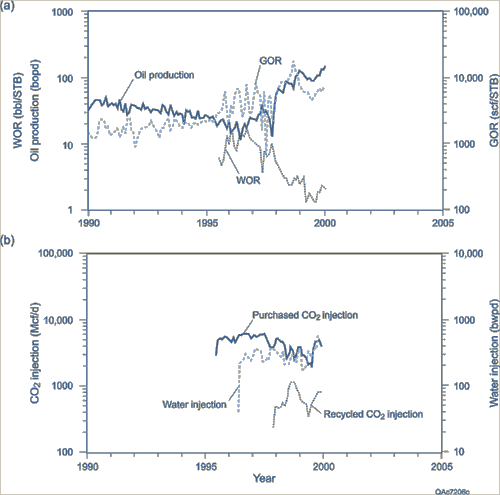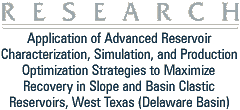 TECHNICAL
PROGRESS REPORT TECHNICAL
PROGRESS REPORT
PROGRAM
INFORMATION
Cooperative
Agreement No.: DE-FC22-95BC14936
Institution:
Bureau of Economic Geology
The University
of Texas at Austin
University
Station, Box X
Austin, Texas
78713-7508
Date of Report: April
30, 2000
Award Date: March
31, 1995
Anticipated Completion
Date for this Budget: August 31, 2000
Government Award
for this Budget Period: $341,403
Program Manager: Daniel
Ferguson
Principal Investigator: Shirley
P. Dutton
Contracting Officer's
Representative: Daniel Ferguson
Reporting Period: January
1, 2000 - March 31, 2000
OBJECTIVES
The objective of this
Class 3 project is to demonstrate that detailed reservoir characterization
of slope and basin clastic reservoirs in sandstones of the Delaware Mountain
Group in the Delaware Basin of West Texas and New Mexico is a cost effective
way to recover a higher percentage of the original oil in place through
strategic placement of infill wells and geologically based field development.
Project objectives are divided into two main phases. The original objectives
of the reservoir-characterization phase of the project were (1) to provide
a detailed understanding of the architecture and heterogeneity of two
representative fields of the Delaware Mountain Group, Geraldine Ford and
Ford West, which produce from the Bell Canyon and Cherry Canyon Formations,
respectively, (2) to chose a demonstration area in one of the fields,
and (3) to simulate a CO2 flood in the demonstration area.
After the reservoir
characterization and simulation of an area at the northern end of the
Ford Geraldine unit were completed, the industry partner decided not to
proceed to Phase 2, installation of a CO2 flood in the demonstration area.
A new industry partner, Orla Petco, Inc., will participate in the remainder
of the project, which includes a field demonstration in the East Ford
unit. The East Ford unit is immediately adjacent to the Ford Geraldine
unit and produces from the same Ramsey sandstone channel. The reservoir
characterization phase of the project was expanded to include the East
Ford unit. This additional reservoir-characterization task provided an
excellent opportunity to test the transferability of the geologic model
and log-interpretation methods developed during reservoir characterization
of the Ford Geraldine unit to another Delaware sandstone field.
The objectives of
the implementation phase of the project remain the same, to (1) apply
the knowledge gained from reservoir characterization and simulation studies
to increase recovery from a demonstration area, (2) demonstrate that economically
significant unrecovered oil can be recovered by a CO2 flood of the demonstration
area, and (3) test the accuracy of reservoir characterization and flow
simulation as predictive tools in resource preservation of mature fields.
The goal is to develop a geologically designed CO2 flood and well-completion
program in a representative Delaware Sandstone field that can serve as
a model for other fields in the play. Through technology transfer, the
knowledge gained in this study can be applied to increase production from
more than 100 other Delaware Mountain Group reservoirs.
top
of page
SUMMARY
OF TECHNICAL PROGRESS
Field
Implementation
The project is now
in Phase 2, field implementation of a CO2 flood. Tertiary recovery in
the East Ford unit by CO2 injection began in July, 1995, and production
response to the CO2 injection was observed in December, 1998 (fig. 1).
In 1993 and 1994, before the CO2 flood began, annual production from the
field was 12,000 to 14,000 bbl of oil. In 1998, annual production had
increased to more than 30,000 bbl. In 1999 production has risen to 38,791
bbl. Daily production from the field increased from 30 bbl/day to more
than 100 bbl/day (fig. 1).
Poor production response
observed in well 4 suggests that a barrier restricts communication between
this producing well and injector well 2; the barrier may be caused by
geologic heterogeneity. Initial geologic interpretations suggested the
presence of a channel—levee boundary between wells 3 and 4 in the
Ramsey 2 sandstone. To overcome this restriction, well 3 was brought into
production. Production from well 3, however, quickly became a mirror image
of well 4, about 15 bbl of oil per day, approximately the same amount
of water, and little gas. Well 3 was then shut in to run a pressure build-up
test. The test indicates the presence of a flow barrier approximately
65 ft away. The nature of the barrier is unknown; it could be a low-permeability
levee deposit or it may have been caused by deposition of solids in the
formation over a long production time. The low volume of CO2 produced
in well 3 suggests that the barrier occurs between wells 2 and 3 and not
between wells 3 and 4. This evidence has caused us to remap the Ramsey
2 levee so that it passes between wells 2 and 3.
Some of the production
problems in the East Ford unit may be caused by horizontal (or "pancake")
fractures that were created in some of the wells during fracture stimulation.
Evidence is not sufficient to say that all wells have horizontal fractures,
but it is clear some of them do. Wells that were initially completed open
hole in the Ramsey 2 and later deepened into the Ramsey 1 were able to
recover cores of the Ramsey 1 sandstone, suggesting a horizontal fracture
had been created in the Ramsey 2. In deeper Delaware fields where this
has been done, only frac sand was recovered from the Ramsey 1, suggesting
a vertical fracture had been created. Wells that were deepened in the
East Ford unit, but not cored, drilled as if they were cutting formation,
not frac sand, and the cuttings were from the formation and not frac sand.
Tracer surveys on injection wells and some production wells also indicate
some horizontal fractures.
As part of the Phase
2 field demonstration, a new well has been permitted and will be drilled
as soon as a rig becomes available. The new well is located just northwest
of well 41. Well 41 is being replaced because its casing parted during
a workover to repair a casing leak. The new well will be logged with a
density tool to measure the density of all the layers above the Ramsey
sandstone. With this information, overburden pressure at the reservoir
can be calculated and used to determine the pressure at which horizontal
fractures will form. The goal is to design a fracture treatment for well
3 that stays below the pressure that would cause horizontal fracturing.
We will then be able to determine if the flow restriction that occurs
65 ft from well 3 is caused by a levee or if it is due to deposition of
solids. If it is caused by solids deposition, it should be possible to
treat past the damage. If the restriction appears to be caused by a levee,
another buildup test will be done.
Technology
Transfer
The
paper "Characterization of reservoir heterogeneity in slope and basin
clastic reservoirs, Bell Canyon Formation, Delaware Basin, Texas"
by S. P. Dutton, M. D. Barton, H. H. Zirczy, and W. A. Flanders was presented
at the Southwest Section AAPG annual meeting in Midland, Texas on February
28. The authors have been notified verbally that their paper received
the A. I. Levorsen Memorial Award for the best paper presented at the
meeting. The paper will be published by the Southwest Section AAPG in
the meeting transactions volume.
top
of page
PLANNED
ACTIVITIES
The CO2 flood in the
East Ford unit will continue next quarter, and a new well will be drilled
to replace well 41. Evaluation of the results of the flood will continue
and will be compared with the geologic interpretation of the field.

Figure
1. Total
field production (a) and injection (b) in the East Ford unit.
top
of page
|



